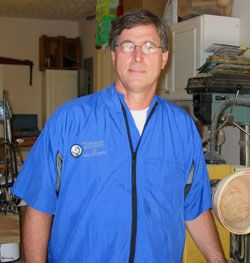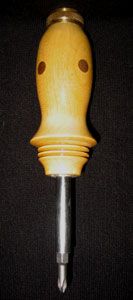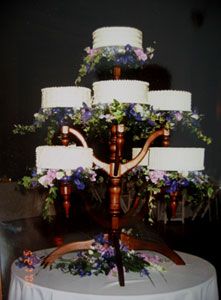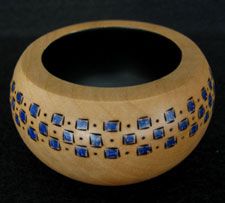
 Doug Hall:
Daryl, congratulations on a Second Place finish in our 4-in-1 Screwdriver Turning Contest. What motivated you to enter?
Doug Hall:
Daryl, congratulations on a Second Place finish in our 4-in-1 Screwdriver Turning Contest. What motivated you to enter?
Daryl Rickard: I was in your store for your Spring Tool Sale and saw the screwdriver kits. I thought they would make good "guy" gifts. It was later when I went online to the Highland Woodworking website that I discovered the contest. Since I was making a Father's Day gift for my dad, I entered the prototype in your contest.
 DH:
In looking at your screwdriver, I noticed that you have used contrasting woods to create accents. Is this a trait of your other turnings.
DH:
In looking at your screwdriver, I noticed that you have used contrasting woods to create accents. Is this a trait of your other turnings.
DR: I love contrasting woods. I have made boxes and accented the tops with a contrasting wood.
DH: Could you describe how you achieved the round inlays on the sides of the handle?
DR: My yellowheart blank was pre-drilled while the blank was square and walnut was inlayed. Then the blank was turned. Once finished, the walnut was just enough to give the handle some interest.
DH: What woods do you enjoy working with and what are the qualities that you look for in choosing a piece of wood to turn? Is it tone, color, figure?
DR: I use mostly native hardwoods. Walnut is my favorite. I love the rich color once finished, red to purple hues. I like to incorporate some sapwood for contrast, particularly in a box. Walnut cuts well cross-grain with minimal tear out. But like most turners, I like any wood that is free!
DH: How long have you been turning? What first attracted you to the craft?
DR: I have turned since the early nineties after purchasing a 12" Delta. I have become more serious since acquiring a 3420A Powermatic two years ago. My first exposure, however, was shop class in the 8th grade.
 DH:
Do you have a piece you are proudest of turning?
DH:
Do you have a piece you are proudest of turning?
DR: My daughter got married 6 years ago. She saw a wedding cake stand that held multiple small cakes, and asked if I could make one. While the one she saw wasn't turned, I decided to design and turn her one. The picture on the left shows the final product. It was a lot of spindle work, which I hadn't done a lot of at the time. Copying multiple parts and making them match was a major accomplishment for me. Of course, I was proud I could do something for my only daughter's major day.
DH: Your pieces are multi-faceted in the techniques involved. Have you always taken this approach with your work?
DR: In June, I attended the American Association of Woodturners national meeting in Louisville, Kentucky. This summer I managed to sit in on many of Michael Hosaluk's demos. He talked about color and texture enhancing his pieces. I came home and began to incorporate color ( milk paint , acrylics, molding paste) and texture (grinding, carving, wire brushing) into my work. I am also experimenting with woodburning, enhanced with thin washes of acrylics. This has appealed to my whimsical side. In the past I have been a purist (only the natural beauty of the wood), but now I like the embellishment. Judging from the instant gallery in Louisville, however, this is not new to many turners.
 DH:
Are there certain tools that you use more that others?
DH:
Are there certain tools that you use more that others?
DR: I am still evolving as a woodturner. I'll try any tool once. That is maybe why I have so many. I use the standard gouges that most turners use. Like many turners, my turning improved when my sharpening became reproducible. I accomplish that with an 8" Delta grinder and a Wolverine grinding jig set. I have modified that with Don Geiger's jig and use David Ellsworth's fingernail grinding jig.
DH: How do your family and friends feel about your turning? Do they share your passion for wood?
DR: I grew up with a woodworking dad. He never turned, but could do everything else with a 10" Craftsman saw, 4" planer, and a drill press. He is 84 and still carves and makes small projects. He is my main wood scavenger now. With that background, my family has always enjoyed wood, and so far I have had no complaints about the turned gifts.
DH: Are there resources that you have found to be helpful in your success with creating unique works from the lathe?
DR: I have a passion for all art ceramic, glass, and painting, to name a few. I love tactile, organic textured art and take every opportunity to visit galleries. I find it energizing. I just came back from the Pacific Northwest and was intrigued by the Native American art. I am sure some facet of the Northwest will find its way into some of my turnings. I have a notebook of small drawings of architectural items, shapes from nature, and edges of pieces seen that I keep as a reference. This helps me when I go to the lathe.
DH: What advice would you give someone on the best way to start turning?
DR: Just do it hands on you cannot just watch. You must get time on a lathe. Learn early how to sharpen. Much of my early days were in the wilderness of unsharp tools and poor grinds. That can be discouraging.
DH: Do you place value on books, DVD's, clubs or classes and is having a mentor important?
DR: All of the above is important. For me, it started with books. I would go to the shop and try to duplicate what I saw in the book, Turning Wood , by Richard Raffan. It still has sawdust within its pages from early turnings. The most valuable thing for me has been membership in local clubs. I was a member of Northcoast Woodturners in Cleveland, Ohio for 3 years before moving to the Atlanta area 3-1/2 years ago. Here I joined the Georgia Association of Woodturners . The monthly demos, critiques of work, symposiums, open forums of members sharing ideas, and problem solving have been invaluable. The passion within the groups, the openness of their members to share information, and the accessibility to artisans pushing the limits of woodturning only serve to make the average turner like me better.
Daryl Rickard resides in Peachtree City, Georgia. He may be contacted via e-mail at darylrickard@comcast.net .
View a slideshow of Daryl's work